Tax Deductibility Analysis: Ruby Pty Ltd Taxation Assignment
VerifiedAdded on 2023/06/03
|7
|1510
|205
Homework Assignment
AI Summary
This assignment solution addresses the tax deductibility of expenses incurred by Ruby Pty Ltd. It analyzes the deductibility of expenses related to the replacement of kitchen fittings, considering whether the expenditure constitutes repairs or capital improvements. The solution references relevant tax legislation, including sections 8-1 and 25-10 of the ITAA 1997, and case law such as TR 97/23. The assignment also examines the deductibility of legal expenses incurred due to a visitor's injury, differentiating between revenue and capital expenditure based on the advantage derived from the expense. Furthermore, the solution covers the capital gains tax (CGT) implications for Betty, an investor and collector, analyzing the disposal of shares, a painting (pre-CGT asset), and a violin (collectible), considering relevant sections of the ITAA 1997, including s. 149(10), s. 104(5), s. 110-25(1), s. 115-25, and s. 118(10) to determine the CGT liability. The solution concludes that no CGT implications would be raised on taxpayer on the account of selling of the violin.
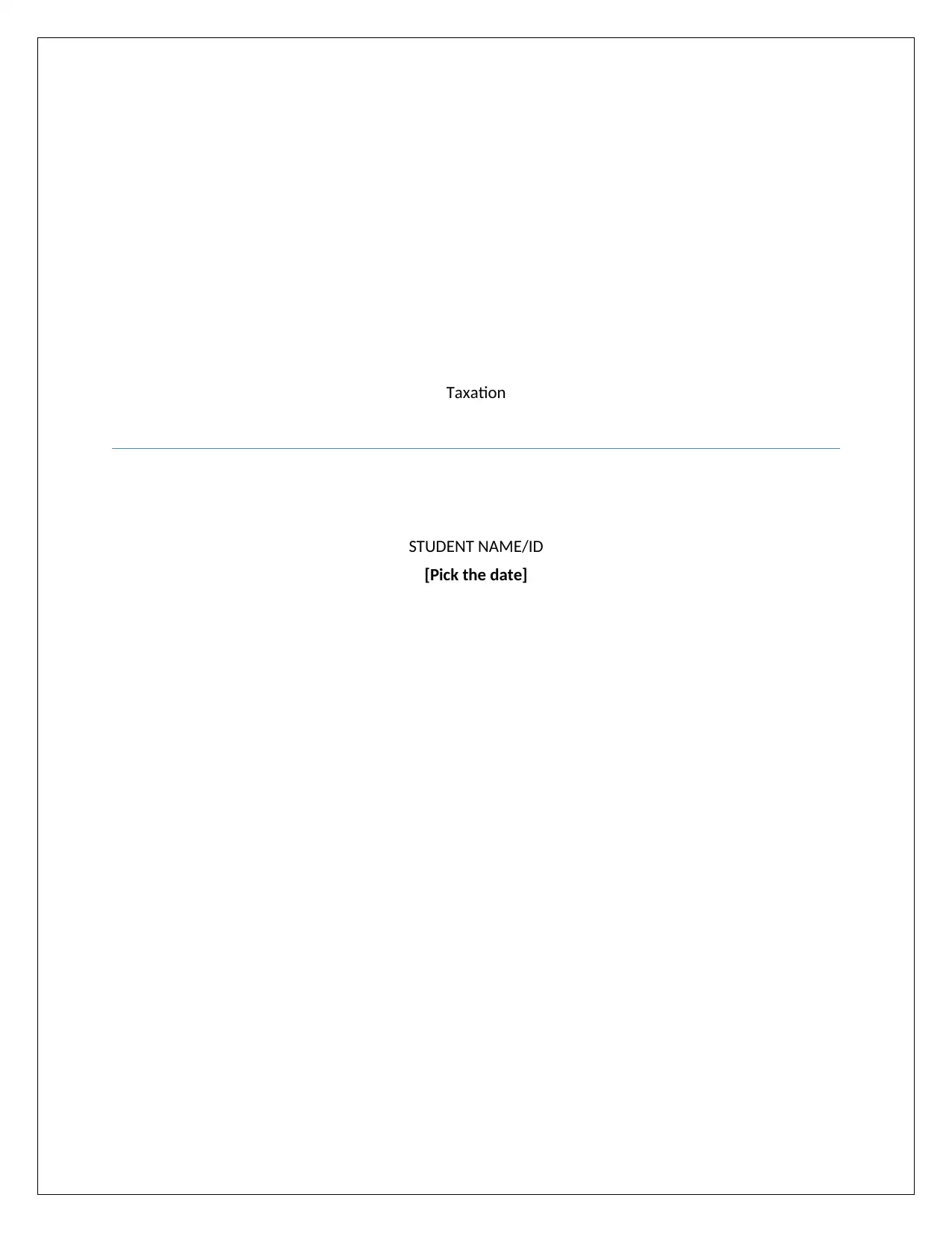
Taxation
STUDENT NAME/ID
[Pick the date]
STUDENT NAME/ID
[Pick the date]
Paraphrase This Document
Need a fresh take? Get an instant paraphrase of this document with our AI Paraphraser
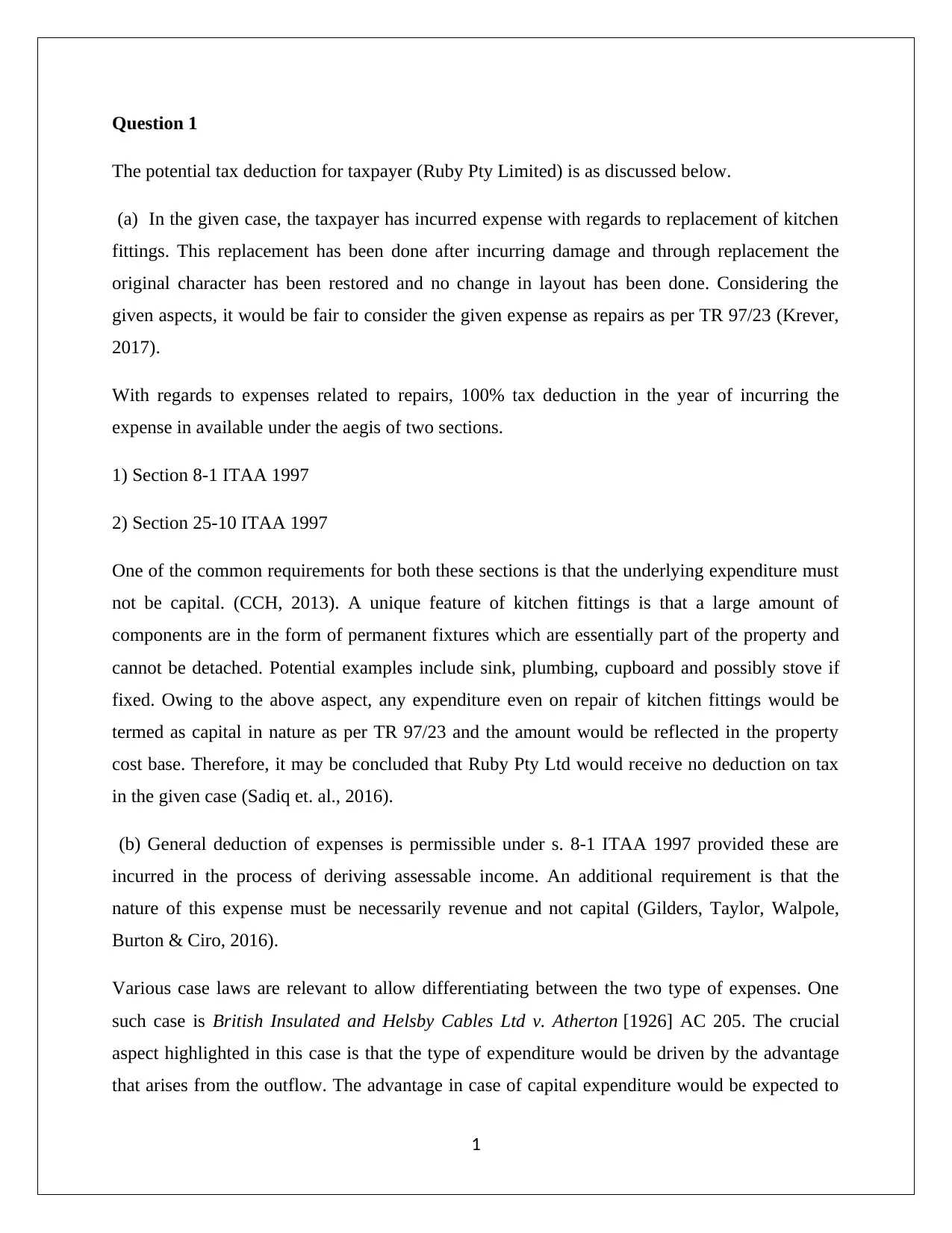
Question 1
The potential tax deduction for taxpayer (Ruby Pty Limited) is as discussed below.
(a) In the given case, the taxpayer has incurred expense with regards to replacement of kitchen
fittings. This replacement has been done after incurring damage and through replacement the
original character has been restored and no change in layout has been done. Considering the
given aspects, it would be fair to consider the given expense as repairs as per TR 97/23 (Krever,
2017).
With regards to expenses related to repairs, 100% tax deduction in the year of incurring the
expense in available under the aegis of two sections.
1) Section 8-1 ITAA 1997
2) Section 25-10 ITAA 1997
One of the common requirements for both these sections is that the underlying expenditure must
not be capital. (CCH, 2013). A unique feature of kitchen fittings is that a large amount of
components are in the form of permanent fixtures which are essentially part of the property and
cannot be detached. Potential examples include sink, plumbing, cupboard and possibly stove if
fixed. Owing to the above aspect, any expenditure even on repair of kitchen fittings would be
termed as capital in nature as per TR 97/23 and the amount would be reflected in the property
cost base. Therefore, it may be concluded that Ruby Pty Ltd would receive no deduction on tax
in the given case (Sadiq et. al., 2016).
(b) General deduction of expenses is permissible under s. 8-1 ITAA 1997 provided these are
incurred in the process of deriving assessable income. An additional requirement is that the
nature of this expense must be necessarily revenue and not capital (Gilders, Taylor, Walpole,
Burton & Ciro, 2016).
Various case laws are relevant to allow differentiating between the two type of expenses. One
such case is British Insulated and Helsby Cables Ltd v. Atherton [1926] AC 205. The crucial
aspect highlighted in this case is that the type of expenditure would be driven by the advantage
that arises from the outflow. The advantage in case of capital expenditure would be expected to
1
The potential tax deduction for taxpayer (Ruby Pty Limited) is as discussed below.
(a) In the given case, the taxpayer has incurred expense with regards to replacement of kitchen
fittings. This replacement has been done after incurring damage and through replacement the
original character has been restored and no change in layout has been done. Considering the
given aspects, it would be fair to consider the given expense as repairs as per TR 97/23 (Krever,
2017).
With regards to expenses related to repairs, 100% tax deduction in the year of incurring the
expense in available under the aegis of two sections.
1) Section 8-1 ITAA 1997
2) Section 25-10 ITAA 1997
One of the common requirements for both these sections is that the underlying expenditure must
not be capital. (CCH, 2013). A unique feature of kitchen fittings is that a large amount of
components are in the form of permanent fixtures which are essentially part of the property and
cannot be detached. Potential examples include sink, plumbing, cupboard and possibly stove if
fixed. Owing to the above aspect, any expenditure even on repair of kitchen fittings would be
termed as capital in nature as per TR 97/23 and the amount would be reflected in the property
cost base. Therefore, it may be concluded that Ruby Pty Ltd would receive no deduction on tax
in the given case (Sadiq et. al., 2016).
(b) General deduction of expenses is permissible under s. 8-1 ITAA 1997 provided these are
incurred in the process of deriving assessable income. An additional requirement is that the
nature of this expense must be necessarily revenue and not capital (Gilders, Taylor, Walpole,
Burton & Ciro, 2016).
Various case laws are relevant to allow differentiating between the two type of expenses. One
such case is British Insulated and Helsby Cables Ltd v. Atherton [1926] AC 205. The crucial
aspect highlighted in this case is that the type of expenditure would be driven by the advantage
that arises from the outflow. The advantage in case of capital expenditure would be expected to
1
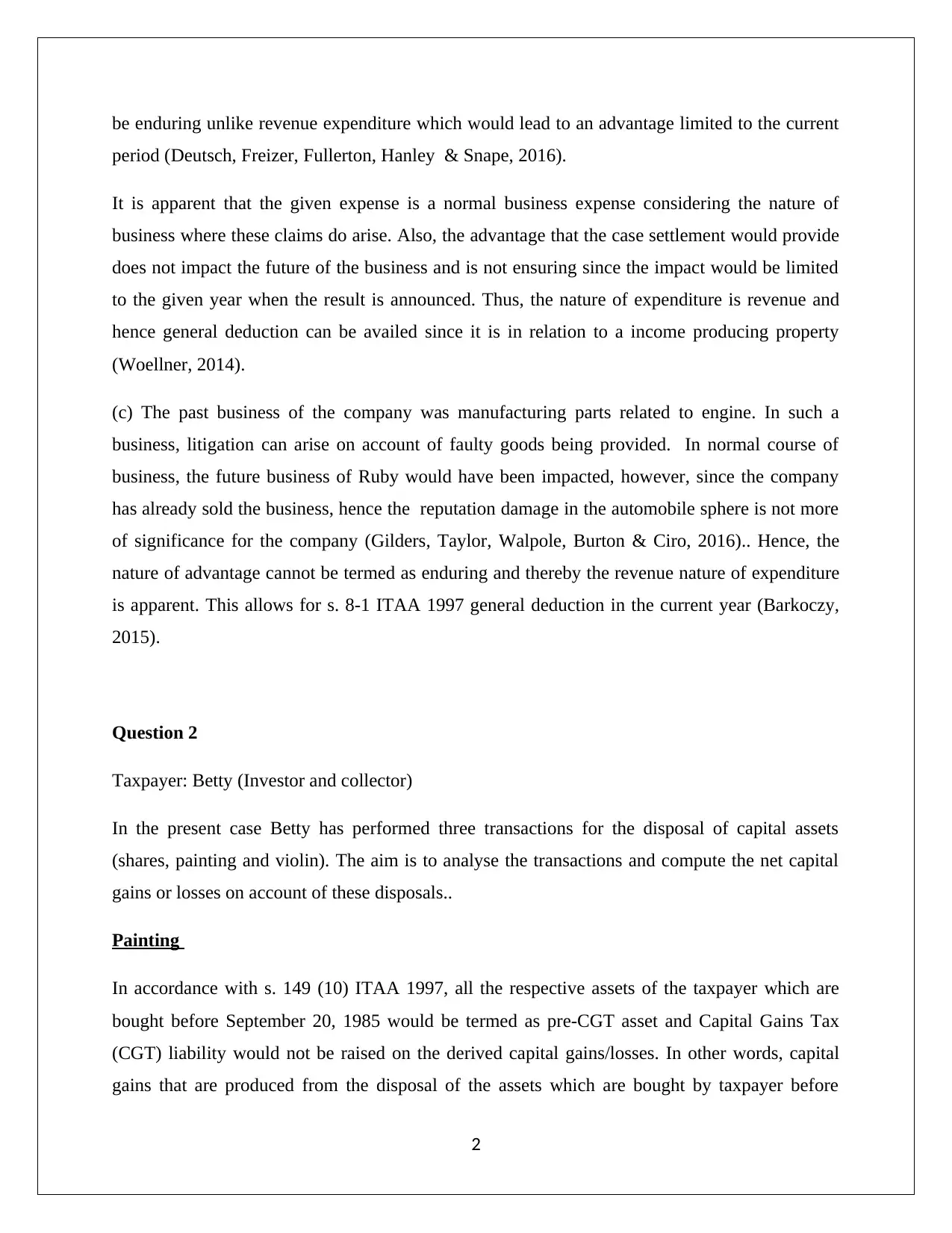
be enduring unlike revenue expenditure which would lead to an advantage limited to the current
period (Deutsch, Freizer, Fullerton, Hanley & Snape, 2016).
It is apparent that the given expense is a normal business expense considering the nature of
business where these claims do arise. Also, the advantage that the case settlement would provide
does not impact the future of the business and is not ensuring since the impact would be limited
to the given year when the result is announced. Thus, the nature of expenditure is revenue and
hence general deduction can be availed since it is in relation to a income producing property
(Woellner, 2014).
(c) The past business of the company was manufacturing parts related to engine. In such a
business, litigation can arise on account of faulty goods being provided. In normal course of
business, the future business of Ruby would have been impacted, however, since the company
has already sold the business, hence the reputation damage in the automobile sphere is not more
of significance for the company (Gilders, Taylor, Walpole, Burton & Ciro, 2016).. Hence, the
nature of advantage cannot be termed as enduring and thereby the revenue nature of expenditure
is apparent. This allows for s. 8-1 ITAA 1997 general deduction in the current year (Barkoczy,
2015).
Question 2
Taxpayer: Betty (Investor and collector)
In the present case Betty has performed three transactions for the disposal of capital assets
(shares, painting and violin). The aim is to analyse the transactions and compute the net capital
gains or losses on account of these disposals..
Painting
In accordance with s. 149 (10) ITAA 1997, all the respective assets of the taxpayer which are
bought before September 20, 1985 would be termed as pre-CGT asset and Capital Gains Tax
(CGT) liability would not be raised on the derived capital gains/losses. In other words, capital
gains that are produced from the disposal of the assets which are bought by taxpayer before
2
period (Deutsch, Freizer, Fullerton, Hanley & Snape, 2016).
It is apparent that the given expense is a normal business expense considering the nature of
business where these claims do arise. Also, the advantage that the case settlement would provide
does not impact the future of the business and is not ensuring since the impact would be limited
to the given year when the result is announced. Thus, the nature of expenditure is revenue and
hence general deduction can be availed since it is in relation to a income producing property
(Woellner, 2014).
(c) The past business of the company was manufacturing parts related to engine. In such a
business, litigation can arise on account of faulty goods being provided. In normal course of
business, the future business of Ruby would have been impacted, however, since the company
has already sold the business, hence the reputation damage in the automobile sphere is not more
of significance for the company (Gilders, Taylor, Walpole, Burton & Ciro, 2016).. Hence, the
nature of advantage cannot be termed as enduring and thereby the revenue nature of expenditure
is apparent. This allows for s. 8-1 ITAA 1997 general deduction in the current year (Barkoczy,
2015).
Question 2
Taxpayer: Betty (Investor and collector)
In the present case Betty has performed three transactions for the disposal of capital assets
(shares, painting and violin). The aim is to analyse the transactions and compute the net capital
gains or losses on account of these disposals..
Painting
In accordance with s. 149 (10) ITAA 1997, all the respective assets of the taxpayer which are
bought before September 20, 1985 would be termed as pre-CGT asset and Capital Gains Tax
(CGT) liability would not be raised on the derived capital gains/losses. In other words, capital
gains that are produced from the disposal of the assets which are bought by taxpayer before
2
⊘ This is a preview!⊘
Do you want full access?
Subscribe today to unlock all pages.

Trusted by 1+ million students worldwide
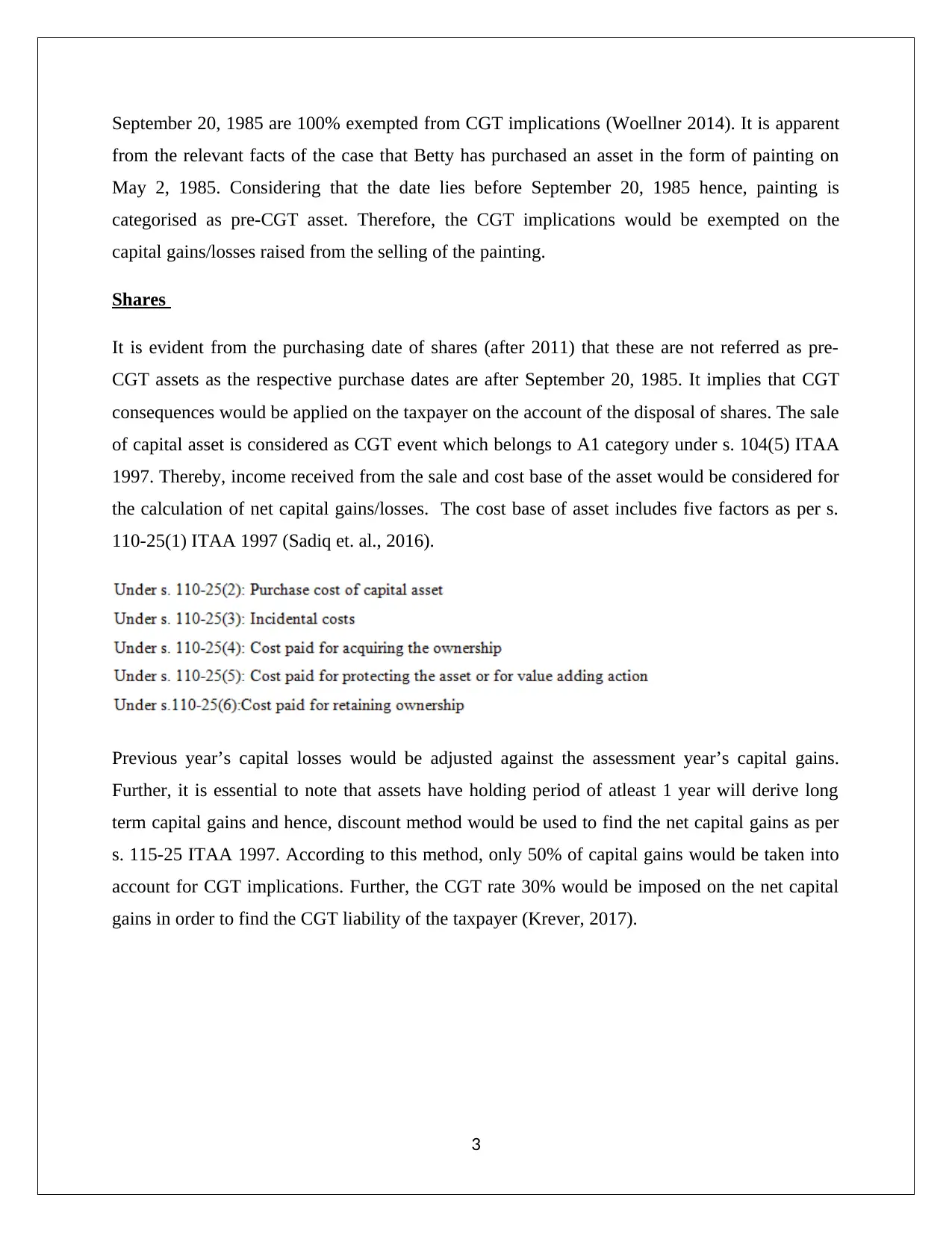
September 20, 1985 are 100% exempted from CGT implications (Woellner 2014). It is apparent
from the relevant facts of the case that Betty has purchased an asset in the form of painting on
May 2, 1985. Considering that the date lies before September 20, 1985 hence, painting is
categorised as pre-CGT asset. Therefore, the CGT implications would be exempted on the
capital gains/losses raised from the selling of the painting.
Shares
It is evident from the purchasing date of shares (after 2011) that these are not referred as pre-
CGT assets as the respective purchase dates are after September 20, 1985. It implies that CGT
consequences would be applied on the taxpayer on the account of the disposal of shares. The sale
of capital asset is considered as CGT event which belongs to A1 category under s. 104(5) ITAA
1997. Thereby, income received from the sale and cost base of the asset would be considered for
the calculation of net capital gains/losses. The cost base of asset includes five factors as per s.
110-25(1) ITAA 1997 (Sadiq et. al., 2016).
Previous year’s capital losses would be adjusted against the assessment year’s capital gains.
Further, it is essential to note that assets have holding period of atleast 1 year will derive long
term capital gains and hence, discount method would be used to find the net capital gains as per
s. 115-25 ITAA 1997. According to this method, only 50% of capital gains would be taken into
account for CGT implications. Further, the CGT rate 30% would be imposed on the net capital
gains in order to find the CGT liability of the taxpayer (Krever, 2017).
3
from the relevant facts of the case that Betty has purchased an asset in the form of painting on
May 2, 1985. Considering that the date lies before September 20, 1985 hence, painting is
categorised as pre-CGT asset. Therefore, the CGT implications would be exempted on the
capital gains/losses raised from the selling of the painting.
Shares
It is evident from the purchasing date of shares (after 2011) that these are not referred as pre-
CGT assets as the respective purchase dates are after September 20, 1985. It implies that CGT
consequences would be applied on the taxpayer on the account of the disposal of shares. The sale
of capital asset is considered as CGT event which belongs to A1 category under s. 104(5) ITAA
1997. Thereby, income received from the sale and cost base of the asset would be considered for
the calculation of net capital gains/losses. The cost base of asset includes five factors as per s.
110-25(1) ITAA 1997 (Sadiq et. al., 2016).
Previous year’s capital losses would be adjusted against the assessment year’s capital gains.
Further, it is essential to note that assets have holding period of atleast 1 year will derive long
term capital gains and hence, discount method would be used to find the net capital gains as per
s. 115-25 ITAA 1997. According to this method, only 50% of capital gains would be taken into
account for CGT implications. Further, the CGT rate 30% would be imposed on the net capital
gains in order to find the CGT liability of the taxpayer (Krever, 2017).
3
Paraphrase This Document
Need a fresh take? Get an instant paraphrase of this document with our AI Paraphraser
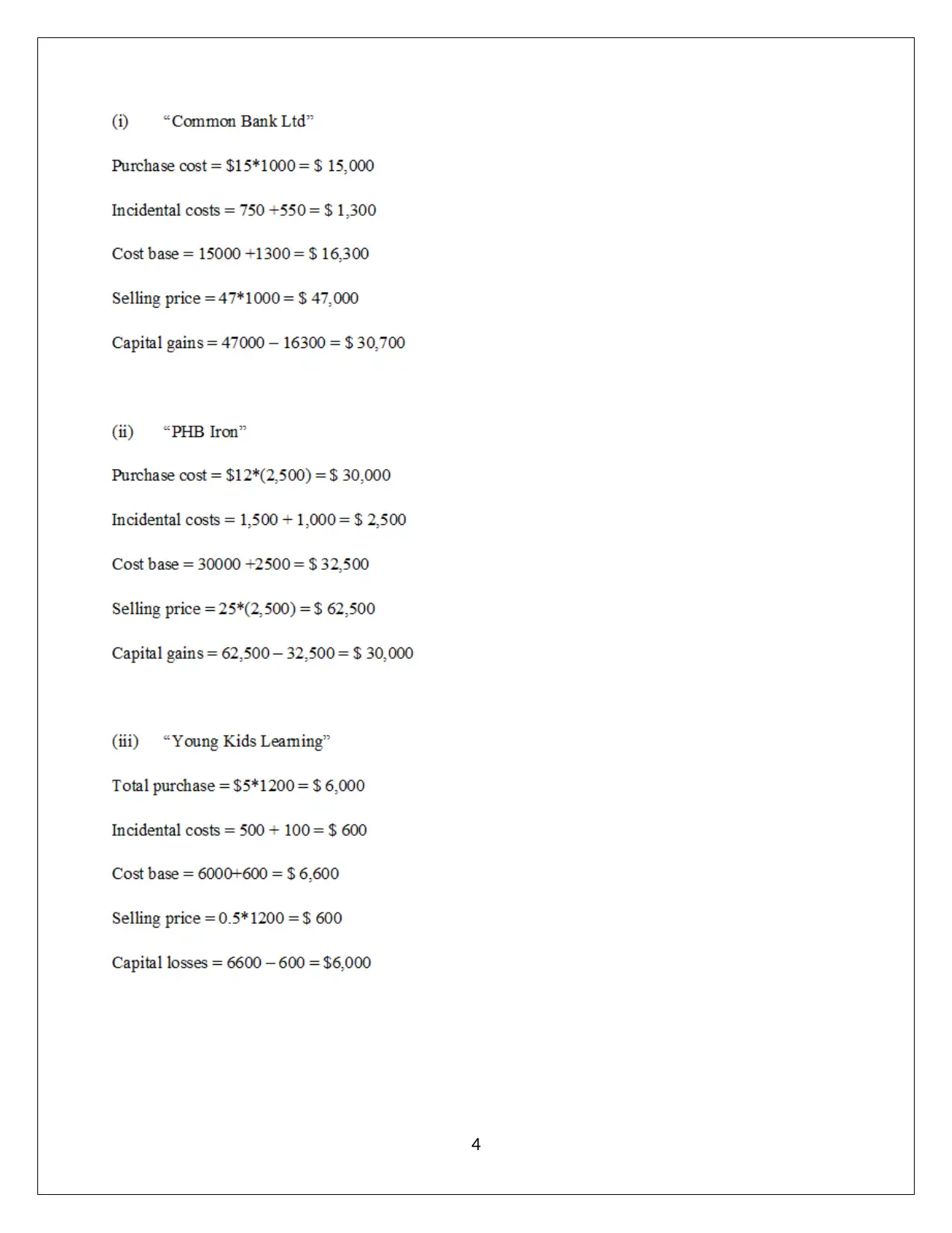
4
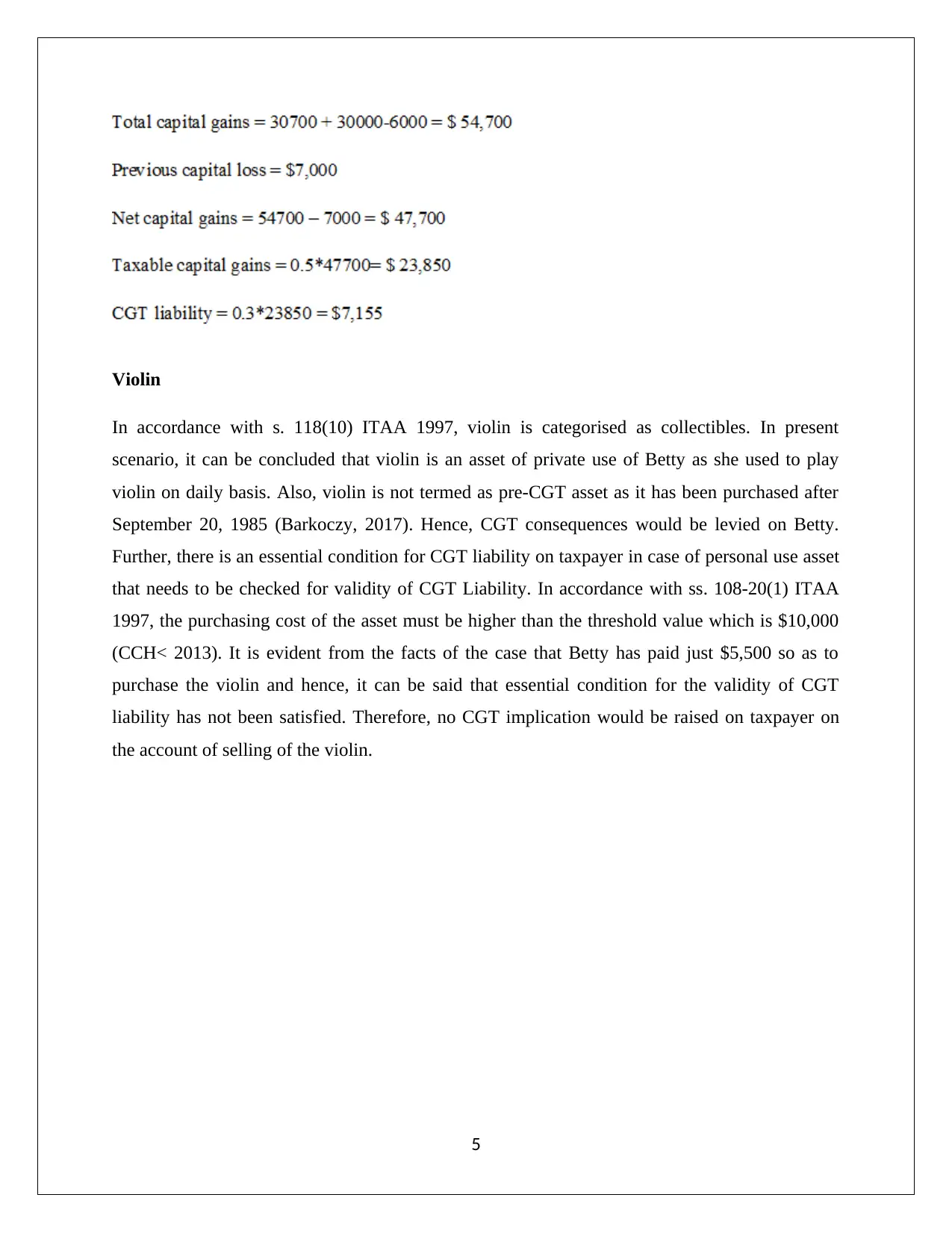
Violin
In accordance with s. 118(10) ITAA 1997, violin is categorised as collectibles. In present
scenario, it can be concluded that violin is an asset of private use of Betty as she used to play
violin on daily basis. Also, violin is not termed as pre-CGT asset as it has been purchased after
September 20, 1985 (Barkoczy, 2017). Hence, CGT consequences would be levied on Betty.
Further, there is an essential condition for CGT liability on taxpayer in case of personal use asset
that needs to be checked for validity of CGT Liability. In accordance with ss. 108-20(1) ITAA
1997, the purchasing cost of the asset must be higher than the threshold value which is $10,000
(CCH< 2013). It is evident from the facts of the case that Betty has paid just $5,500 so as to
purchase the violin and hence, it can be said that essential condition for the validity of CGT
liability has not been satisfied. Therefore, no CGT implication would be raised on taxpayer on
the account of selling of the violin.
5
In accordance with s. 118(10) ITAA 1997, violin is categorised as collectibles. In present
scenario, it can be concluded that violin is an asset of private use of Betty as she used to play
violin on daily basis. Also, violin is not termed as pre-CGT asset as it has been purchased after
September 20, 1985 (Barkoczy, 2017). Hence, CGT consequences would be levied on Betty.
Further, there is an essential condition for CGT liability on taxpayer in case of personal use asset
that needs to be checked for validity of CGT Liability. In accordance with ss. 108-20(1) ITAA
1997, the purchasing cost of the asset must be higher than the threshold value which is $10,000
(CCH< 2013). It is evident from the facts of the case that Betty has paid just $5,500 so as to
purchase the violin and hence, it can be said that essential condition for the validity of CGT
liability has not been satisfied. Therefore, no CGT implication would be raised on taxpayer on
the account of selling of the violin.
5
⊘ This is a preview!⊘
Do you want full access?
Subscribe today to unlock all pages.

Trusted by 1+ million students worldwide
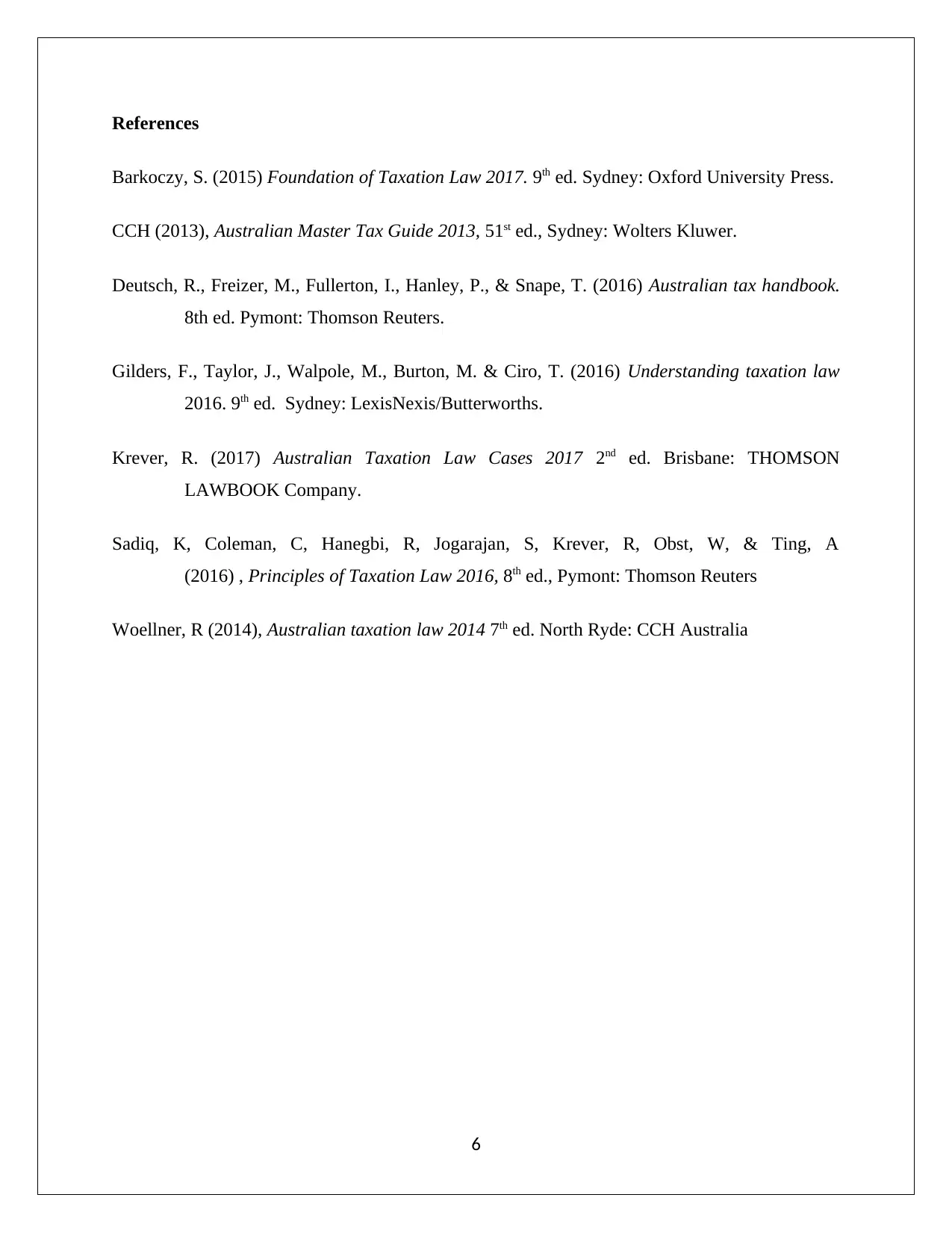
References
Barkoczy, S. (2015) Foundation of Taxation Law 2017. 9th ed. Sydney: Oxford University Press.
CCH (2013), Australian Master Tax Guide 2013, 51st ed., Sydney: Wolters Kluwer.
Deutsch, R., Freizer, M., Fullerton, I., Hanley, P., & Snape, T. (2016) Australian tax handbook.
8th ed. Pymont: Thomson Reuters.
Gilders, F., Taylor, J., Walpole, M., Burton, M. & Ciro, T. (2016) Understanding taxation law
2016. 9th ed. Sydney: LexisNexis/Butterworths.
Krever, R. (2017) Australian Taxation Law Cases 2017 2nd ed. Brisbane: THOMSON
LAWBOOK Company.
Sadiq, K, Coleman, C, Hanegbi, R, Jogarajan, S, Krever, R, Obst, W, & Ting, A
(2016) , Principles of Taxation Law 2016, 8th ed., Pymont: Thomson Reuters
Woellner, R (2014), Australian taxation law 2014 7th ed. North Ryde: CCH Australia
6
Barkoczy, S. (2015) Foundation of Taxation Law 2017. 9th ed. Sydney: Oxford University Press.
CCH (2013), Australian Master Tax Guide 2013, 51st ed., Sydney: Wolters Kluwer.
Deutsch, R., Freizer, M., Fullerton, I., Hanley, P., & Snape, T. (2016) Australian tax handbook.
8th ed. Pymont: Thomson Reuters.
Gilders, F., Taylor, J., Walpole, M., Burton, M. & Ciro, T. (2016) Understanding taxation law
2016. 9th ed. Sydney: LexisNexis/Butterworths.
Krever, R. (2017) Australian Taxation Law Cases 2017 2nd ed. Brisbane: THOMSON
LAWBOOK Company.
Sadiq, K, Coleman, C, Hanegbi, R, Jogarajan, S, Krever, R, Obst, W, & Ting, A
(2016) , Principles of Taxation Law 2016, 8th ed., Pymont: Thomson Reuters
Woellner, R (2014), Australian taxation law 2014 7th ed. North Ryde: CCH Australia
6
1 out of 7
Related Documents
Your All-in-One AI-Powered Toolkit for Academic Success.
+13062052269
info@desklib.com
Available 24*7 on WhatsApp / Email
![[object Object]](/_next/static/media/star-bottom.7253800d.svg)
Unlock your academic potential
Copyright © 2020–2025 A2Z Services. All Rights Reserved. Developed and managed by ZUCOL.





